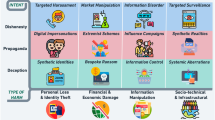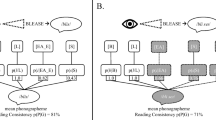Abstract
This paper describes KAZOO, a web application for sign language (SL) generation using a virtual signer. Firstly, it explains the motivation to this project, which is grounded on an approach designed solely from SL corpus analysis and modelling. Then, various projects conducted in the past few years on linguistic modelling and 3D animation are presented. The platform’s architecture integrates parts of this work and new pieces of software allowing control and linking of all these components. This is an ongoing project, though the current version offers the possibility to animate a virtual signer automatically and synthesize the contents using an abstract representation, the authors’ own linguistic model AZee, providing a means of validating this model.











Similar content being viewed by others
References
Braffort, A., Chételat-Pelé, E.: Analysis and description of blinking in French sign language for automatic generation. In: Efthimiou, E., Kouroupetroglou, G., Fotinea, S.-E. (eds.) Gesture and Sign Language in Human–Computer Interaction and Embodied Communication, LNCS/LNIA, vol. 7206, pp. 173–182. Springer, Berlin (2012)
Braffort, A., Filhol, M.: Constraint-Based Sign Language Processing. In: Blache, P., Christiansen, H., Dahl, V., Duchier, D., Villadsen, J. (eds.) Constraints and Language, Cambridge Scholar Publishing, Cambridge, pp. 191–217 (2014)
Braffort, A., Bolot, L., Segouat, J.: Virtual signer coarticulation in octopus, a sign language generation platform. In: Efthimiou, E., Kouroupetroglou, G. (eds.) 9th International Gesture Workshop (GW’11): Gesture in Embodied Communication and Human–Computer Interaction, ILSP/ATHENA RC and National and Kapodistrian University of Athens, pp. 29–32 (2011)
Delorme, M.: Modélisation du squelette pour la génération réaliste de postures de la langue des signes française. Ph.D. thesis, Paris-Sud University (2011)
Delorme, M., Filhol, M., Braffort, A.: Thumb modelling for the generation of sign language. In: Efthimiou, E., Kouroupetroglou, G., Fotinea S.-E. (eds.) Gesture and Sign Language in Human–Computer Interaction and Embodied Communication, LNCS/LNIA, vol. 7206, pp. 151–160. Springer, Berlin (2012)
Efthimiou, E., Fotinea, S.-E., Hanke, T., Glauert, J., Bowden, R., Braffort, A., Collet, C., Maragos, P., Lefebvre-Albaret, F.: Sign language technologies and resources of the dicta-sign project. In: 5th Workshop on the Representation and Processing of Sign Languages: Interactions between Corpus and Lexicon. Satellite Workshop to the 8th International Conference on Language Resources and Evaluation (LREC 2012), ELRA, pp. 37–44 (2012)
Filhol, M.: Modèle descriptif des signes pour un traitement automatique des langues des signes. Ph.D. thesis, Université Paris-Sud (2008)
Filhol, M.: Combining two synchronisation methods in a linguistic model to describe sign language. In: Efthimiou, E., Kouroupetroglou, G., Fotinea, S.-E. (eds.) Gesture and Sign Language in Human–Computer Interaction and Embodied Communication, LNCS/LNAI, vol. 7206, pp. 194–203. Springer, Berlin (2012)
Filhol, M., Braffort, A.: A study on qualification/naming structures in sign languages. In: 5th Workshop on the Representation and Processing of Sign Languages: Interactions between Corpus and Lexicon. Satellite Workshop to the 8th International Conference on Language Resources and Evaluation (LREC 2012), ELRA, pp. 63–66 (2012)
Filhol, M., Braffort, A.: What constraints for representing multilinearity in sign language? In: Duchier, D., Parmentier, Y. (eds.) 7th International Workshop on Constraint Solving and Language Processing (CSLP 2012), LIFO. Orléans University, Orléans (2012)
Filhol, M., Hadjadj, M., Testu, B.: A rule triggering system for automatic text-to-sign translation. In: Wolfe, R., McDonald, J. (eds.) 3rd International Symposium on Sign Language Translation and Avatar Technology (SLTAT 2013). De Paul University (2013)
Filhol, M., Hadjadj, M., Choisier, A.: Non-manual features: the right to indifference. In: 6th Workshop on the Representation and Processing of Sign Languages: Beyond the manual channel. Satellite Workshop to the 9th International Conference on Language Resources and Evaluation (LREC 2014), pp. 49–54 (2014)
Hanke, T.: Will there ever be a market for signing avatars? some observations on the past and future of our field. In: Wolfe, R., McDonald, J. (eds.) 3rd International Symposium on Sign Language Translation and Avatar Technology (SLTAT 2013). De Paul University (2013)
Hanke, T., Storz, J.: iLex—a database tool integrating sign language corpus linguistics and sign language lexicography. In: 3th Workshop on the Representation and Processing of Sign Languages: Construction and Exploitation of Sign Language Corpora. Satellite Workshop to the 6th International Conference on Language Resources and Evaluation (LREC 2008), ELRA, pp. 64–67 (2008)
Huenerfauth, M., Lu, P.: Effect of spatial reference and verb inflection on the usability of sign language animations. Universal Access in the Information Society 11(2), 169–184 (2012). doi:10.1007/s10209-011-0247-7
Huenerfauth, M.P.: Generating American sign language classifier predicates for English-to-ASL machine translation. Ph.D. thesis, University of Pennsylvania (2006)
Jennings, V., Efthimiou, E., Kennaway, R., Glauert, J.: Requirements for a signing avatar. In: 4th Workshop on the Representation and Processing of Sign Languages: Corpora and Sign Languages Technologies. Satellite Workshop to the 7th International Conference on Language Resources and Evaluation (LREC 2010), ELRA, Paris pp. 133–136 (2010)
Kipp, M., Heloir, A., Nguyen, Q.: Sign language avatars: Animation and comprehensibility. In: Proceedings of the 10th International Conference on Intelligent Virtual Agents, Springer, Berlin, Heidelberg, IVA’11, pp. 113–126 (2011). http://dl.acm.org.gate6.inist.fr/citation.cfm?id=2041666.2041682
Kipp, M., Nguyen, Q., Heloir, A., Matthes, S.: Assessing the deaf user perspective on sign language avatars. In: 13th international ACM SIGACCESS conference on Computers and accessibility (ASSETS’11), ACM, pp. 107–114 (2011)
López-Colino, F., Colás, J.: Hybrid paradigm for Spanish sign language synthesis. Journal of Universal Access in the Information Society (UAIS) 11(2), 151–168 (2012)
Marshall, I., Sáfár, E.: Grammar development for sign language avatar-based synthesis. In: 3rd International Conference on Universal Access in Human-Computer Interaction (UAHCI2005), Lawrence Erlbaum Associates (2005)
Morrissey, S.: Assessing three representation methods for sign language machine translation and evaluation. In: Mikel, L., Forcada, V.V., Heidi Depraetere (eds.) 15th Annual Meeting of the European Association for Machine Translation (EAMT 2011), EAMT, pp. 137–144 (2011)
San-Segundo, R., Barra, R., Córdoba, R., Fernando D’Haro, L., Fernández, F., Ferreiros, J., Manuel Lucas, J., Macías-Guarasa, J., Manuel Montero, J., Manuel Pardo, J.: Speech to sign language translation system for Spanish. Speech Communication 50(11–12), 1009–1020 (2008)
Segouat, J.: Modélisation de la coarticulation en langue des signes française dans le contexte de la diffusion automatique d’informations en gare ferroviaire à l’aide d’un signeur virtuel. Ph.D. thesis, Université Paris-Sud (2010)
Segouat, J., Braffort, A.: Toward modeling sign language coarticulation. In: Kopp, S., Wachsmuth, I. (eds.) Gesture in Embodied Communication and Human–Computer Interaction, LNCS/LNAI, vol. 5934, pp. 325–336. Springer, Berlin (2010)
Wolfe, R., Cook, P., McDonald, J.C., Schnepp, J.: Linguistics as structure in computer animation: toward a more effective synthesis of brow motion in American sign language. Sign Lang. Ling. 14(1), 179–199 (2011)
Wu, C.H., Su, H.Y., Chiu, Y.H., Lin, C.H.: Transfer-based statistical translation of Taiwanese sign language using PCFG. ACM Trans. Asian Lang. Inf. Process. (TALIP) 6(1), 1–18 (2007)
Author information
Authors and Affiliations
Corresponding author
Rights and permissions
About this article
Cite this article
Braffort, A., Filhol, M., Delorme, M. et al. KAZOO: a sign language generation platform based on production rules. Univ Access Inf Soc 15, 541–550 (2016). https://doi.org/10.1007/s10209-015-0415-2
Published:
Issue Date:
DOI: https://doi.org/10.1007/s10209-015-0415-2




